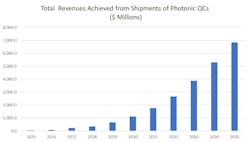Photonic Quantum Computer shipments to reach $6.8B by 2035, says IQT Research
Here’s some key highlights:
· IQT Research forecasts that worldwide revenues from photonic quantum computers will have reached $1.1 billion shipped.
· Photonic quantum computers’ growth will reflect supply and demand factors.
· IQT estimates that 20 vendors are developing photonic quantum computing platforms.
· Quantum chemistry, including both drug design and materials discovery, has become a popular application for QCs.
IQT Research sees great potential in photonic quantum computers, predicting it will be a multi-billion-dollar market in the next decade.
By 2030, the research firm forecasts that worldwide revenues from photonic quantum computers will have reached $1.1 billion shipped, but this number will grow to more than $6.8 billion by 2035.
IQT said growth will reflect both supply and demand factors.
On the supply side, new companies will be entering the photonic computer market. Likewise, on the demand side, IQT expects demand for QCs “will increase dramatically, and this high growth will impact photonic QCs as much as any other area.”
“We expect the market share for photonic quantum computers to be around 20-25 percent of all QCs at the end of the forecasting period,” IQT Research said.
Quantum funding accelerates
Today, 20 vendors are developing photonic quantum computing platforms, with PsiQuantum having attracted the most significant funding to date and Xanadu attracting investors’ attention.
In March, Quantum computing startup PsiQuantum announced it was raising $750 million at a $6 billion pre-money valuation. The company is manufacturing its light-based qubits on silicon chips at GlobalFoundries and has introduced techniques to improve hardware efficiency and reduce computation time. According to a Reuters report, BlackRock is leading the fundraising effort.
Xanadu has raised $275 million in total funding to date from a group of Canadian investors.
Along with raising funding, Xanadu announced a collaboration with Corning to develop customized fibre and fiber-array solutions to enable low-loss networking of photonic quantum computing chips.
Opportunities and challenges
Being an ever-emerging market opportunity, the photonic quantum computing market has great potential in various applications.
For example, Quantum chemistry, including both drug design and materials discovery, has become a popular application for QCs. PsiQuantum, QC82 and Photonic have cited quantum chemistry as a key target for their platforms.
Photonic QCs are being looked at as a platform for new quantum computing architectures such as measurement-based quantum computing.
Other companies are collaborating on a continuous variable (CV) architecture that uses deterministic quantum teleportation.
Photonic Inc.’s T Centre architecture uses photons to network silicon spin qubits, leveraging high qubit connectivity, telecom fiber, and COTS optical switches, and offers competitive ratios of physical to logical qubits with fast error correction cycles.
Despite the potential of photonic QCs, IQT Research noted that “the economics of photonic computers have yet to be proven.”
One key issue is adapting off-the-shelf photonic components to a quantum environment, which can raise costs. While room-temperature operation is specific for some elements, some photon sources and photon detectors for photonic quantum computers require cryogenics, as do readouts.
IQT cited how Rotonium claims the cost of photonic computing will decline from $115,000 to $29,000 by 2028 due to the momentum of Moore’s Law.
By leveraging Orbital Angular Momentum (OAM) properties of photons, Rotonium said it can build room-temperature photonic quantum computers that are easily scalable and designed for edge computing applications. Further, it said that because it has a simpler design of quantum circuits, it can reduce size and costs.
For related articles, visit the Business Topic Center.
For more information on high-speed transmission systems and suppliers, visit the Lightwave Buyer’s Guide.
To stay abreast of fiber network deployments, subscribe to Lightwave’s Service Providers and Datacom/Data Center newsletters.
About the Author
Sean Buckley
Sean is responsible for establishing and executing the editorial strategy of Lightwave across its website, email newsletters, events, and other information products.


